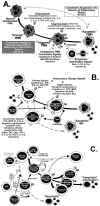Mechanisms of immune resolution
- PMID: 12907886
- PMCID: PMC2248698
- DOI: 10.1097/01.CCM.0000081438.04801.D9
Mechanisms of immune resolution
Abstract
Initially after injury, the innate/proinflammatory and some aspects of the acquired immune response are up-regulated to maintain a defense against foreign pathogens, clear tissue debris present at the wound site, and orchestrate aspects of tissue remodeling, cell proliferation and angiogenic process, associated with the wound response. However, for proper wound healing to progress, this initial inflammatory response has to be regulated or shut down so as to allow for the reestablishment of matrix, recellularization, and tissue remodeling. Inability to properly resolve the extent of innate/acquired response at a site of injury can lead to poor wound healing, immune suppression, and recurrent infectious episodes. This review attempts to summarize information on regulatory mechanisms that are thought to be involved in controlling/resolving innate or acquired immune responses so as to provide a framework for use in thinking about the impact these processes and their manipulation may have on wound healing and its potential management.
Figures


 .
.

References
-
- Chettibi S, Ferguson MWJ. Wound repair: An overview. In: Gallin JI, Snyderman R, editors. Inflammation: Basic Principles and Clinical Correlates. Philadelphia: Lippincott, Williams, and Wilkins; 1999. pp. 865–881.
-
- Hart J. Inflammation: 1. Its role in the healing of acute wounds. J Wound Care. 2002;11:205–209. - PubMed
-
- Schaffer M, Barbul A. Lymphocyte function in wound healing and following injury. Br J Surg. 1998;85:444–460. - PubMed
-
- Martin CW, Muir IFK. The role of lymphocytes in wound healing. Br J Plast Surg. 1990;43:655–662. - PubMed
Publication types
MeSH terms
Grants and funding
LinkOut - more resources
Full Text Sources
Other Literature Sources
Medical

